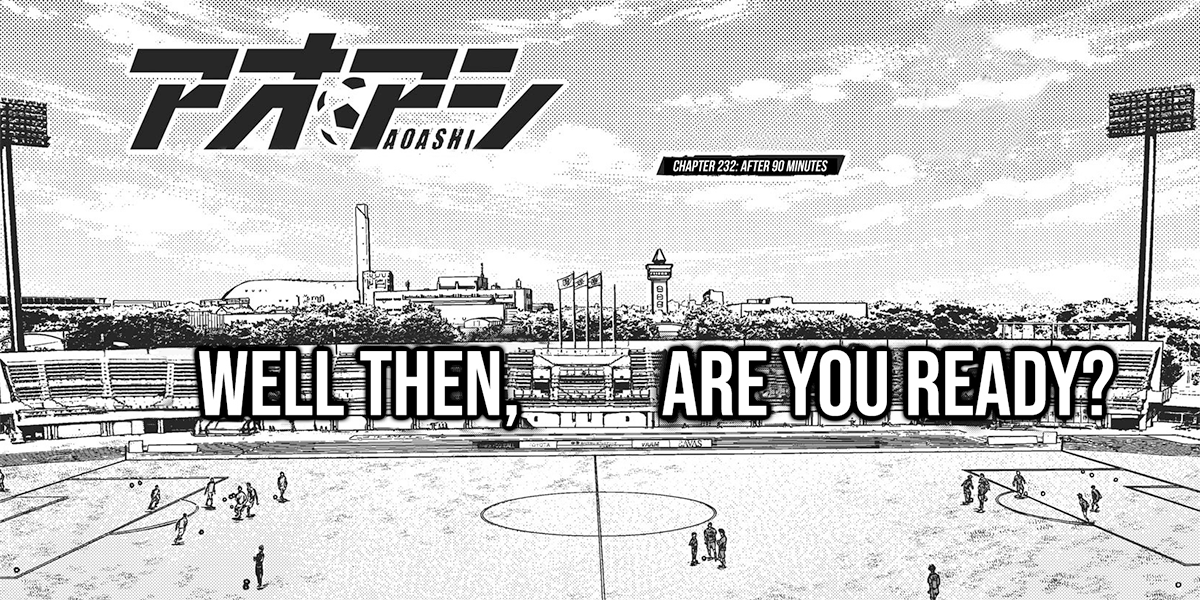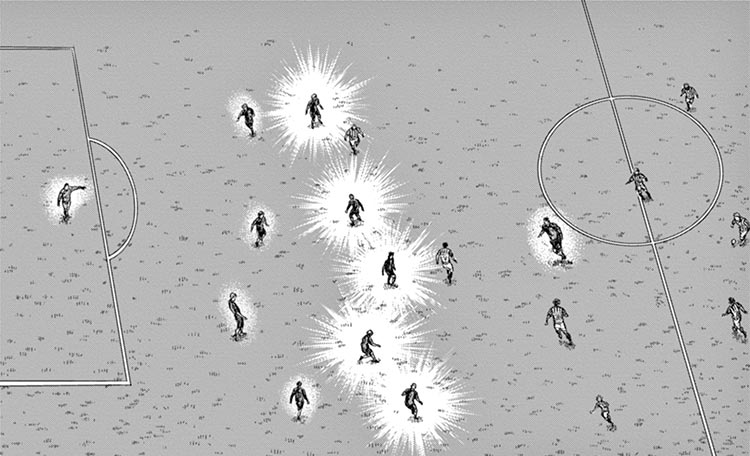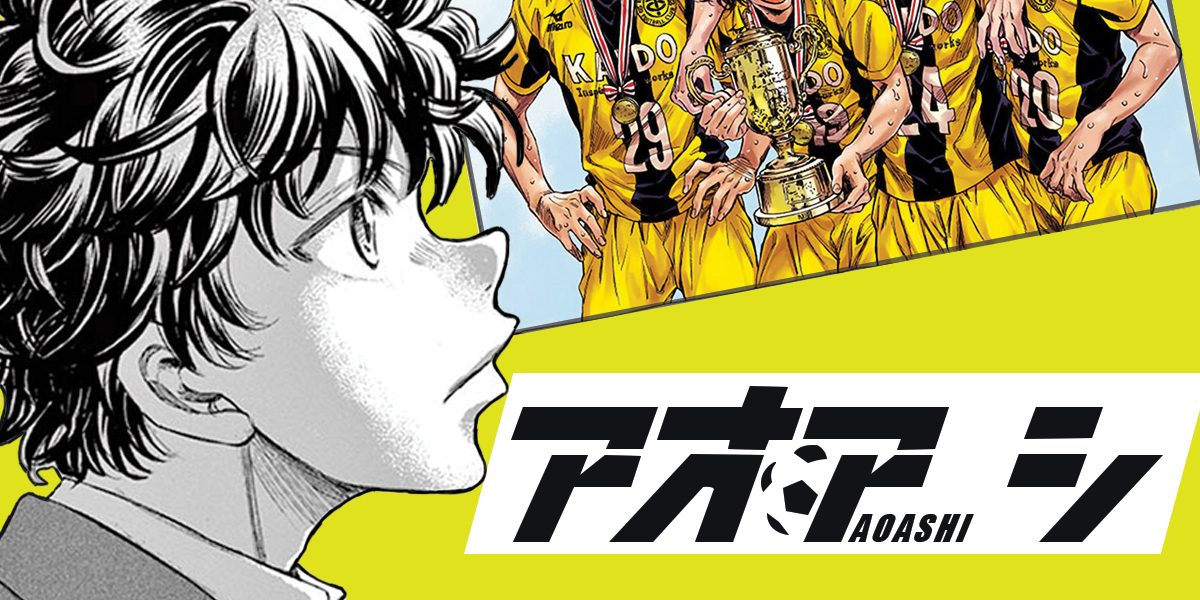Housekeeping and spoilers
Hello there! No spoilers to speak of in this blog post; just more talking about what I enjoy in the series.
If you want to hear me read out this article, I’ve put out a video as a sample of the benefits that patrons get! Watch it below!
This week I wanted to talk about Aoashi, a football manga I’ve been enjoying for the last couple months.
Despite not being a sports guy in real life, it’s been funny to see the series that I’ve been feeling the most engrossed by involve them. I’ve written about Haikyuu!! and Giant Killing in the past, and I like them both for similar reasons: it’s more about the psychology and personal growth of the people involved, rather than just wanting to see your favorites win.
I’ve been reading Aoashi for a couple months now, and now that the scanlation group is caught up to raws, I feel comfortable writing about what I enjoy about the series. Like with Giant Killing, I really liked how Aoashi focused on a different element of sports that I don’t see covered as often: the one that involves player psychology, growth, and the mental fortitude it takes to succeed in a professional feeder system.

With many other sports manga, you find your base within high school competition, since it provides an easy structure, backdrop, and reason for your characters to be together. You have your initial get-togethers, and then fall into the cycle of tournaments, leagues, and “chasing the big win before we graduate.” This generates drama on its own, because there’s a ticking clock and the element of acceptable failure.
However, with Aoashi, the ticking clock is less about the goal of “winning the big one” and more about the individual player’s progress on the path to becoming a pro. This puts a unique spin on a genre that has its share of tropes, and I wanted to explore that a bit.
A quick sidebar
As a side note, I’d like to shout out Be Blues! Project for scanlating a mammoth 171 chapters of Aoashi in 107 days. This summer was pretty much me and a friend getting treated to 2-3 chapters every day, and being able to discuss them. The weekly wait is going to suck now. Aoashi is unfortunately unavailable in English at the time of this posting. Support licensed versions when they’re available.
Aoashi and going pro

Aoashi focuses on Aoi Ashito, a forward from Ehime Prefecture, Japan. Scouted by Fukuda, a former pro footballer who played professionally overseas, he leaves his rural area to travel to Tokyo and join Esperion FC’s youth system. Coming from a poor family who are content to sacrifice to give him this shot, Ashito’s goal is to go pro himself.
While Ashito is talented in the small pond of Ehime — scoring endless goals and running circles around his opponents — he finds himself out of his depth in Tokyo, where his selfish play and lack of fundamentals leads him to struggle. This sink-or-swim environment means that Ashito needs to adjust physically and mentally, especially when it conflicts with how he previously enjoyed football.
The feeling of Fukuda playing favorites with Ashito (in the sense of believing in his potential) is an early theme for me, mostly because I’m almost seeing how far the series wants to dip into typical shonen territory. Because Esperion is a focused factory of putting out professional players, the typical “magic” of the main character is pushed down a significant amount. There aren’t any “mystical techniques” or absurd power gaps, which leads it to feel grounded.
I found this refreshing, mostly because I would much rather see how a person reacts to the adversity and how they handle the resulting need to realign themselves. Both Giant Killing and Aoashi have this grounded feeling, and I find character development much more interesting.

This was something I touched on with my piece on Haikyuu!! and that main character being disappointed with meeting his idol. Instead of being driven by one person’s example, he’s now put in the position to define his own goals. That means we get to see how he adapts.
The pro system of sports is merciless, and as I read Aoashi I couldn’t help but be reminded of the documentary Hoop Dreams. Having a more realistic view of just how few people go pro in a sport and how difficult the competition is makes success sweeter. With Hoop Dreams, neither of the subjects made it to the NBA, and learning that was sobering; while obviously this manga isn’t going to have Ashito fail in his quest, they’re at least realistic about where he has to start.
Setting and structure
Because the goal of the protagonist is to go pro, there’s a lot of room for Aoashi to avoid typical problems with stakes, structure, and seeing progress.
When I read other sports manga, the idea of that end goal is very strong and apparent; normally, you’ll have the story divided into “games” and “off the field” moments, and the differences are very stark. Wins and losses inform how the team develops, and you’ll usually see a pattern of “game arc ► training arc ► game arc.”
In Aoashi, the backdrop of Esperion’s progress doesn’t seem like something that’s shoved in our faces as often. Ashito starts on the “B Youth” team, and his progress to joining the “A Youth” team means shuffling between a starter and substitute, and sometimes not playing at all. This puts less stress on the narrative to show the team’s progress, and I really like that.
Seeing the team lose doesn’t hit as hard when one loss doesn’t mean a tournament exit, and regardless, the characters are improving throughout. Again, the goal isn’t to win the season. The goal is to see Ashito and company move through the ranks of youth football while growing as players and people.
Giant Killing had a very similar vibe to this, but was more “whole team” rather than individual players; Aoashi is mostly just focused on Ashito as a main character, without spending swaths of time doing sidebars with others or playing out games where he doesn’t benefit.
While we do have secondary characters, the nature of promotion, relegation, substitutions and injuries almost make them seem temporary: even the trope of having the “main three” characters that join with each other on the first day gets disrupted when some of those players are promoted from the B to A team, and vice-versa.
Without this focus of the unit, we get a lot more strategy and psychology talk, which I really like. If you’ve never had a deep appreciation for tactical soccer, but are interested, this series goes a long way to help bring you up to speed.

With this in mind, you can see change in terms of characters being able to execute things where they didn’t before. You see evolution as to how they act on the pitch, and you get surprised with the idea of “oh, yeah, that makes a lot of sense” when it’s revealed how they best influence their teammates.
For instance, there’s a character named Otomo, who instantly stood out as a shonen stereotype to me. As part of that “main trio” of characters that Ashito finds himself part of during the opening days of practice, he fell into that “comic relief, girl-crazy, party guy” type of person that every story feels it needs. As time went on, Otomo kind of snuck into a very regular position as a midfielder despite not doing anything particularly special in the context of the plot.
I found myself going “okay, why is he there?” whenever a pre-game meeting would happen with the team’s formation would be announced. A good friend of mine (hey, eba) made a point of tracking these starting lineups because it gave a good marker to the progress of players in general: it allowed him to ask questions about the mixup of older and younger players, as well as who was in form or not.

With Otomo, it didn’t hit me until the manga specifically told us that he was captain material. According to the stereotype I assigned him, I wouldn’t have thought this at all: an equivalent character in Eyeshield 21 would have been temperamental, easily provoked, competitive and short-sighted for comic relief.
Otomo isn’t that. Despite having all the markers of that kind of character, he actually is very level-headed and mature. Despite being a shorter person, he’s able to read the field, and that stature doesn’t define his character as perpetually trying to make up for his lack of solid body. He’s just there in all the ways the team needs him to be, all while providing a stable emotional core. Otomo makes solid personality reads for what people react to, and as a result, he consistently performs.
It’s not sexy, and it’s not as flashy as the shonen stereotype would want to be in service of the plot. He doesn’t do some magic passing technique, make himself pseudo-invisible, or link up his teammates in some kind of mind meld; he’s just consistent and he has a skillset that Ashito can’t do.
But there’s a reason why shonen stories are rarely about the realities of going pro: sometimes your character doesn’t need to be anything more than what gets them to that level.
Keeping up the pace
I tried to avoid rolling pacing into the above section, mostly because I think it deserves its own mention.
In sports manga (especially ones based around high school teams), I feel the rhythm of a series is almost traditional.
- The character is a prodigy, discovered, or otherwise found to have some supernatural talent.
- The team is formed with a core, but incomplete lineup.
- The team plays an initial game or two, carried by the team’s innate talent and a lack of skill of their opponents.
- The team assembled the rest of its members, either from people recovering from injuries, or needing to be coaxed back to the team after departures.
- The team takes part in the first tournament of the year, meets its series rival team, and loses, sometimes due to the thwarting of its raw talent.
- The team takes part in a training arc to break its barriers and become a fundamentally sound team. It discovers its strengths in the process and unites as a roster.
- The team takes part in the second tournament of the year, and wins it. Alternatively, the team loses at a heavy cost, but win the moral victory of being underdogs and “going the distance.” Typically, the rival team from before is either met in the finals, or are defeated on the way to meeting the true “big bad.”
- (Optional) The team takes part in an international or “all-star” tournament for fanservice and closure. All the rivals over the course of the series join together for a “super team.”
Aoashi doesn’t have these things, and the fact it doesn’t means that there’s more time spent off the field, learning. I personally love this structure way more, because more pages and chapters are devoted to personal progress, rather than depicting a match.
With certain sports, entire chapters of a manga (and therefore, a week’s wait) can be taken up with moving the ball from one end of the playing field to another. This means that in-story matches can take months of real-life time to play out.
If you can read these in bulk, it flies by, but going week-to-week means a slow slog of “okay, I know what’s going to happen in this game for the sake of the plot, but I need to wait until next year for us to get back to what I really care about.” Haikyuu!! exacerbated this problem by having the series focus to other teams’ games, where the protagonists weren’t even involved.

Obviously, this is talking to my personal tastes, rather an an objective marker of “what makes a series good”, but I personally love how Aoashi doesn’t waste the readers’ time. If Ashito isn’t playing, a match is going to take two-to-three chapters, tops, to resolve. If he is playing, there’s more focus on skipping chunks of time to show highlights, usually putting into practice what characters have learned off the field.
I love seeing players process and make adjustments based on their personalities and learning styles, and I don’t just want to see a game of soccer play out just for its own sake.
Aoashi treats games as an application, for good or bad: people don’t succeed automatically, and consequences are real, as well. Ashito screwing up majorly means he’s on the bench for two straight games, but that doesn’t mean he can’t comment, learn, or grow in the meantime. A supporting cast of other substitutes, older players, or spectators means people know what to expand on for the sake of the plot, and you become committed in the process.
Wrapping it up
It’s a strange feeling going from having upwards of five new chapters a day to having to wait a week for one. I don’t know how much this affected my enjoyment of Aoashi, or how much it might’ve hide flaws in the process.
However, when comparing to Giant Killing and Haikyuu!!, there’s almost a sliding scale of qualities that I’m starting to build with the sports manga I read:
- How much in the game the focus? How much do wins and losses count?
- How much time is spent on personal development and progress? Is it limited to one team, or a specific player?
- How much is spent on characters that never play? How much are fans involved?
While Giant Killing tends to be focused on the team of East Tokyo United, Aoashi makes Esperion FC more of a setting. The system of youth football feeding into a pro career is focused around how staff, support, and teammates craft a person with potential into the top of their field.

I find myself not caring about how Esperion as a team does, whereas I would with ETU; the latter has more focus on the team’s identity as underdogs, showing how their fanbase suffered through tough times.
While both Giant Killing and Aoashi are both seinen manga as opposed to shonen, they’re both different flavors; it’s kind of like the difference between chocolate chip ice cream and mint chocolate chip. If you want that little shift in the balance between sports and personal growth, you read the other one, and see how it shapes your position on where you started.
I think that’s what I enjoy most about Aoashi; it feels like I’ve gathered more taste as to what makes the series’ I like special, and that’s all I can ask from it.
Note!
Starting in 2023, more of my writing will be on Substack, with only certain, personal posts making their was to this site. Consider subscribing to support my work.
Amazon links on this post may be affiliate links to help support Matt.


Leave a Reply